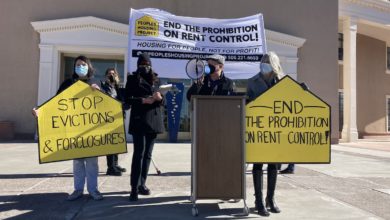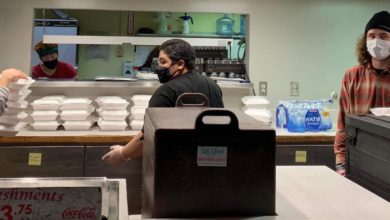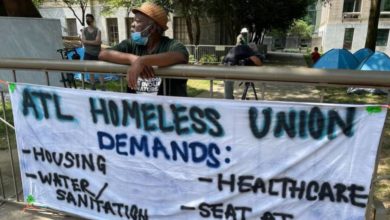During the past several months, organizers, concerned residents and working-class tenants have mobilized in an attempt to prevent the eviction of seven low-income families from two buildings in Cincinnati’s West End. The tenants are being displaced to make way for a $200 million soccer stadium for a team owned by the billionaire Carl Linder III. Construction of this stadium will surely lead to the gentrification of the West End, which borders the Over-The-Rhine neighborhood that has been subject to years of gentrification resulting in the displacement of 80 percent its Black working-class residents.
Over-the-Rhine became ripe for gentrification in the wake of the 2001 police killing of Timothy Thomas, an unarmed 19-year-old. Thomas was the third Black man killed by Cincinnati Police in a six-month span, and the 15th to be killed in the previous six years. The killings, along with years of racial profiling and police brutality sparked a three-day uprising that brought the city to a halt. The Mayor imposed a curfew, enforced primarily in Black neighborhoods, that resulted in over 800 arrests. This type of structural violence is often crucial for gentrification to begin in earnest, as it causes property values to bottom-out and populations to decline, allowing developers to grab land for pennies on the dollar.
While Over-the-Rhine has been subject to years of gentrification, the adjacent West End had been largely ignored by the developers until it became clear that FC Cincinnati would seek to build a 20,000-seat stadium in the neighborhood. Despite considering two other sites; one across the Ohio River in Covington, Ky at an abandoned IRS site facility and another in the middle-class Oakley neighborhood, the team insisted on targeting the West End. Last year, the West End Community Council voted overwhelming (50-10) in opposition to the stadium, citing fears of displacement. Despite this, FC Cincinnati convinced the President of the Community Council to sign off on a community benefits agreement (a move for which he was impeached), giving the impression of community approval and allowing the project to go forward.
President of FC Cincinnati Jeff Berding was adamant at the time that the project would not displace any current residents of the West End. He even scoffed at the idea, telling local media in early 2018:
“Let me stress this: We’re not taking anyone’s homes. We’re going to increase home ownership. we’re going to increase the number of people living in a neighborhood. The notion that we’re somehow going to try to buy people’s homes out, move people out of the neighborhood, that’s just false. That’s just made up.”
As it turns out, it was Berding’s statement that was “just made up.” Not only is it impossible for such projects not to lead to the indirect displacement of residents, but Berding’s lie was made even more egregious when the team surreptitiously purchased two buildings north of the stadium site. In February of this year, residents of those two buildings were given notices by the buildings’ former owner that the building had been sold and they would have to be out in 70 days.
Among residents facing displacement was a 99-year-old woman named Mary Frances Page and her niece who also acts as her caregiver. Other residents face mobility issues and receive Section 8 vouchers that help subsidize their housing. If any of these residents are evicted, they will likely lose their Section 8 eligibility. These factors make it extremely difficult to find adequate affordable housing in a city that already faces an affordable housing deficit of 40,000 units. The residents decided to organize themselves and fight to save their homes, forming Fight Back Cincinnati: Wade St. and Central Ave. Tenants United.
Fight Back Cincinnati and their supporters packed city zoning meetings, demanding that the zoning commission and city council oppose any changes related to the stadium until FC Cincinnati reached an agreement with the tenants facing displacement. The tenants put forth a proposed compromise, in which tenants from one of the two buildings would move into the second building, which would be renovated by the team and deeded to a community housing organization and serve as permanent affordable housing. Faced with a militant and organized community, along with the visceral imagery of 99-year-old woman and her caretaker facing homelessness, the Cincinnati City Council was forced to adopt a resolution in support of the tenants’ compromise.
The struggle only intensified from there however, as the capitalist Berding was enraged by the City Council failing to bend to his every whim. He railed against the organizers assisting the tenants, calling them “professional agitators” and bemoaned the fact that “City Council acts as if we’re some plague upon the city.” Berding was referring to the body that had only a year prior allocated nearly $40 million of public money to build a parking garage in support of the stadium project.
Despite attacks from the team, the tenants held their ground. Insulted by the suggestion that they were doing someone else’s bidding, the tenants stood by their original demands and continued to organize and galvanize support in the community. As a crucial City Council vote loomed; dozens of supporters gathered at a vacant lot across from the tenants’ building to speak out against gentrification and in favor of the tenants. The event featured speakers from a variety of neighborhoods in Cincinnati, underscoring the widespread effect that gentrification was having across the city. While those gathered were specifically there to show support for the Wade St. and Central Ave. tenants, there was also an expressed desire to build a city-wide movement against the developers that have determined the path of development for Cincinnati for far too long.
On May 30, City Council met to discuss and potentially vote on a zoning request for the stadium site. Despite not containing the parcel of land containing the two buildings in question, the council had raised serious objections to approving any new zoning changes until the tenants were assured replacement housing. Negotiations between FC Cincinnati and the tenants were taking place at City Hall as the council meeting occurred.
After a lengthy public comment in which many voiced their opposition to the displacement of the tenants, council initially voted to delay a final vote on the matter, suggesting that there was not support for FC Cincinnati’s requested zoning changes absent a deal with the residents. However, before the session ended, the tenants and the team reached a deal and the council then passed the measures unanimously.
While FC Cincinnati requested that the terms of the agreement not be disclosed, details that have emerged include allowing the residents to stay until January 31, that the team will work with neighborhood groups to replace the affordable housing being taken off the market and that the tenants will receive an unspecified amount to help cover their relocation. One of the groups that had worked closely with the tenants, the Greater Cincinnati Homeless Coalition, stressed on their social media page that the agreement does not make the tenants whole, but they were able to obtain a much better deal for the tenants thanks to the support from the public. Without the pressure applied by an organized group of residents, the tenants would not have had the leverage to force FC Cincinnati to negotiate in good faith.
This is not the end of the struggle, but only the beginning. The community must remain vigilant as FC Cincinnati has shown that they will be ruthlessly duplicitous as they attempt to remake the West End in their own image for profit. Only a militant and organized working class and its allies are capable of holding corporations like FC Cincinnati accountable and only through direct action can government bodies such as Cincinnati City Council be forced to do the same. The concessions won by the Wade St. and Central Ave. tenants are proof of what can be achieved when the workers and oppressed organize themselves against the odds to fight against the ruling class.






